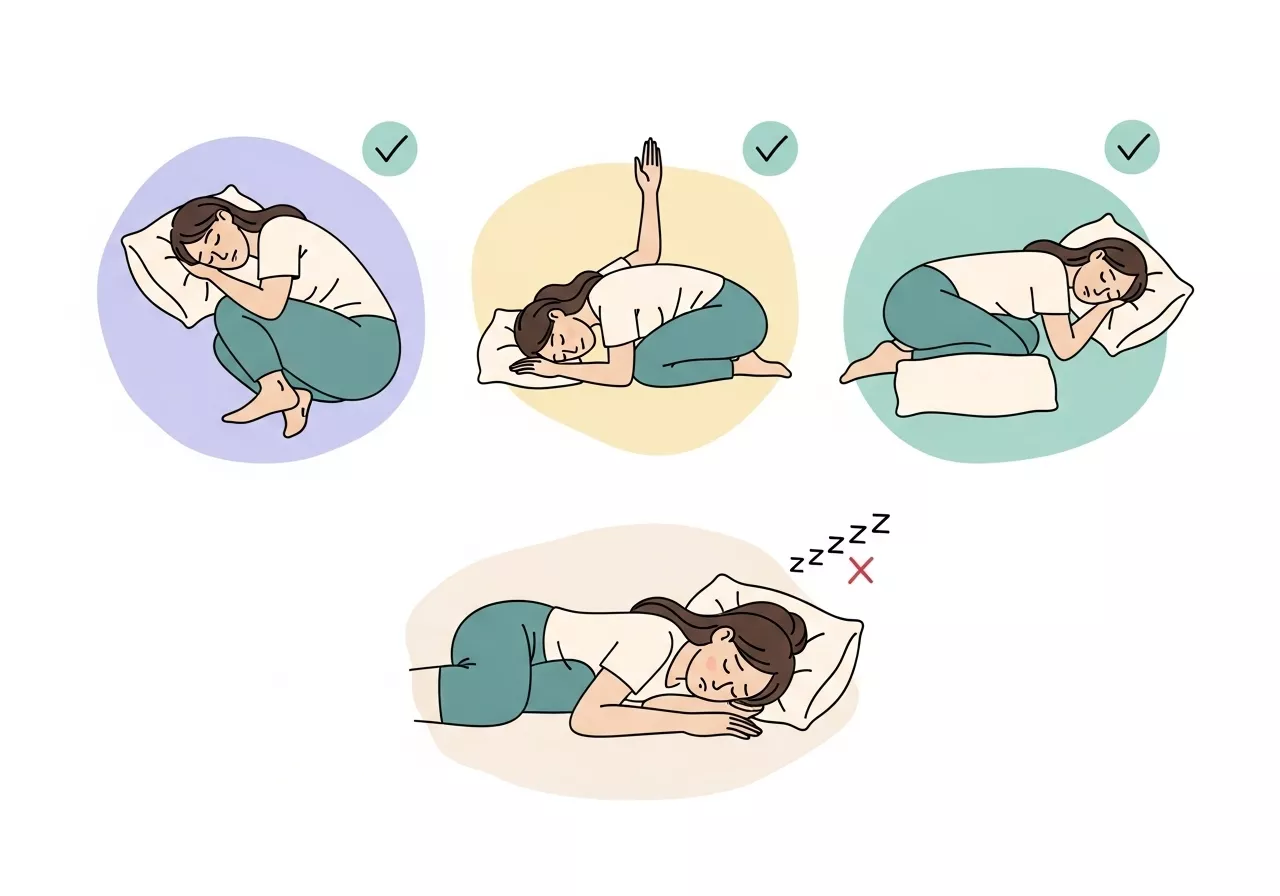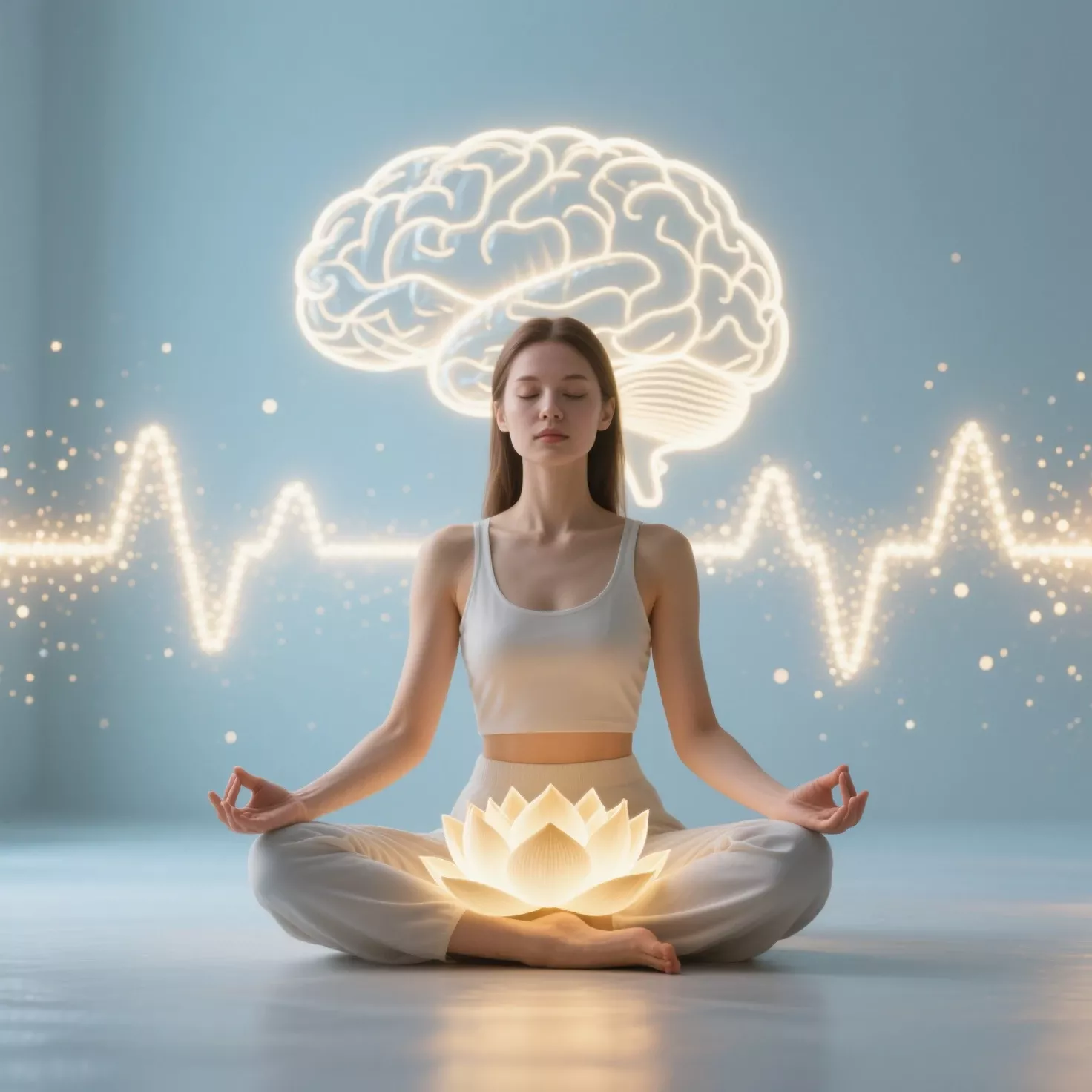Practicing yoga as a couple is an excellent way to build physical fitness, improve flexibility, and enhance emotional connection.
It provides a space to communicate, cooperate, and share mindful moments with your partner.
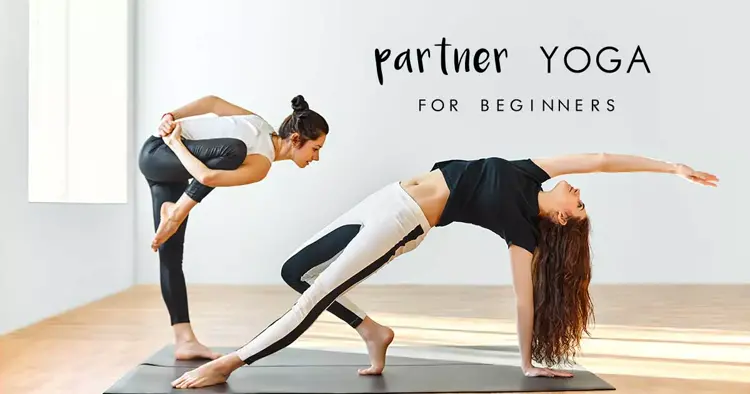
Here are six easy and enjoyable yoga poses for two people:
1. Partner Tree Pose

Benefits:
- Improves Balance and Stability: This pose strengthens your core and leg muscles, helping you develop better balance.
The reliance on each other’s stability teaches you to work as a team to maintain posture. - Symbolizes Growth Together: Just as a tree stands tall and rooted, this pose signifies the steady growth of your relationship.
It’s a visual reminder of mutual support and shared goals. - Encourages Awareness: By focusing on balance, you and your partner become more attuned to your body movements, fostering mindfulness and focus.
How to Perform:
- Stand side by side with your partner, with shoulders touching lightly for initial support.
- Each partner shifts their weight onto the leg closest to each other, firmly grounding the foot.
- Bend the knee of the outer leg and place the sole of that foot on the inner thigh or calf of the supporting leg. (Avoid placing the foot directly on the knee joint to prevent strain.)
- Bring your outside arms overhead, palms touching each other to form a unified arch. Hold each other’s inner hands for balance.
- Focus on a steady point in front of you to help maintain balance. Hold for 5-8 breaths, then switch sides.
2. Double Downward Dog
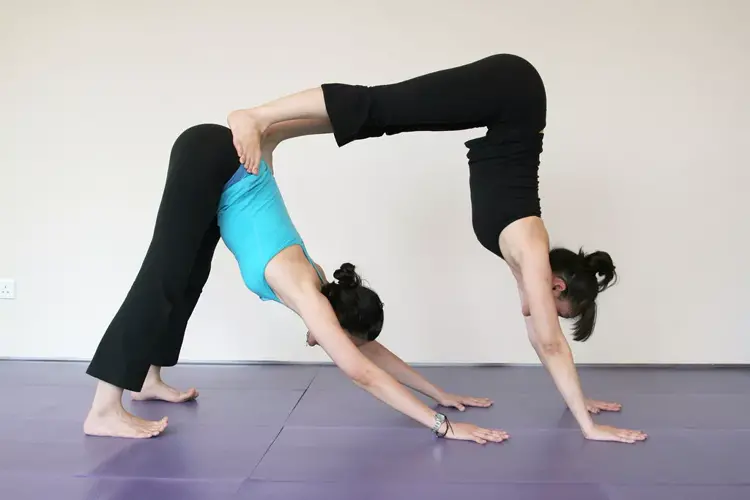
Benefits:
- Enhances Flexibility: This pose stretches your hamstrings, shoulders, and calves, improving overall flexibility while deepening the stretch when aligned with your partner.
- Builds Strength: The weight-bearing aspect of this pose strengthens your arms and legs, while engaging your core to maintain stability.
- Fosters Trust: By sharing the posture and moving in harmony, you build trust in your partner’s physical support, reinforcing emotional connection.
How to Perform:
- Begin by kneeling on the mat facing your partner, then move into the downward dog position (hands and feet firmly on the ground, hips lifted, forming an inverted “V” shape).
- Slowly walk your feet backward or forward until your hands are about a foot apart from your partner’s.
- Maintain this position, ensuring that both your backs are aligned in a straight line.
- If comfortable, one partner can place their feet gently on the lower back of the other partner to deepen the stretch (optional for advanced practice).
- Hold for 5-10 breaths, then switch roles if needed.
3. Back-to-Back Seated Forward Bend
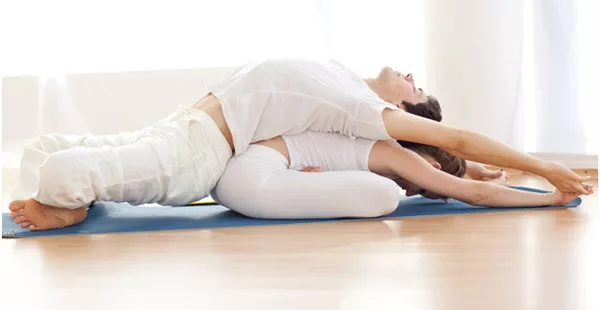
Benefits:
- Promotes Relaxation: This gentle pose stretches your lower back, hamstrings, and hips, releasing built-up tension in these areas.
The leaning motion with your partner creates a calm and soothing experience. - Improves Communication: Because you need to coordinate the leaning movements, this pose enhances non-verbal communication and strengthens your teamwork.
- Balances Energy: Sharing physical support in the forward bend creates a sense of balance and equal give-and-take between you and your partner, symbolizing harmony in your relationship.
How to Perform:
- Sit on the mat with your partner, positioning yourselves back-to-back. Both partners extend their legs straight in front of them, toes pointing upward.
- Sit up tall, engaging your core and ensuring your spines are aligned.
- One partner begins to hinge forward at the hips, reaching for their toes or shins, while the other partner leans back gently to provide support.
- Hold the position for a few deep breaths, then return to the starting position. Switch roles so both partners experience the forward and backward stretches.
4. Partner Boat Pose
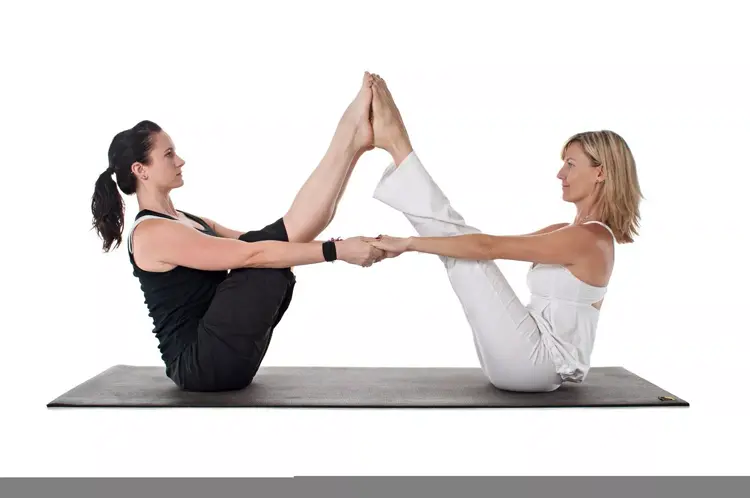
Benefits:
- Builds Core Strength: Maintaining the V-shape position engages your abdominal muscles, improving overall core strength and stability.
- Enhances Coordination: This pose requires synchronized movements to achieve balance, promoting better coordination and teamwork.
- Boosts Confidence and Playfulness: Partner boat pose can feel challenging yet fun. Successfully balancing together boosts confidence and brings out a playful side, adding joy to your practice.
How to Perform:
- Sit on the floor facing your partner, knees bent and feet flat on the mat. Your toes should lightly touch.
- Hold each other’s hands or wrists firmly for stability.
- Lean back slightly, engaging your core muscles, and lift your feet off the ground.
- Slowly extend your legs upward, pressing the soles of your feet together, and balance on your sit bones to form a “V” shape with your bodies.
- Keep your chest open and your back straight. Hold the pose for 5-8 breaths, maintaining eye contact for added connection.
5. Seated Cat-Cow Stretch
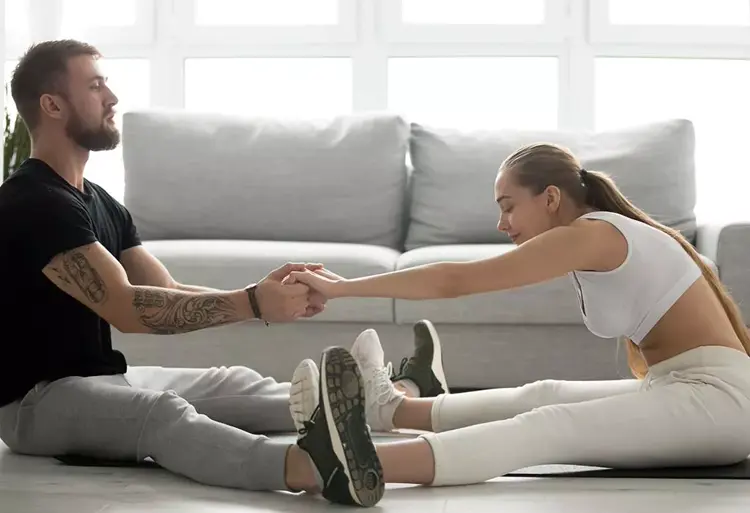
Benefits:
- Improves Spinal Flexibility: The flowing movements between arching and rounding your back release tension and enhance the mobility of your spine.
- Synchronizes Breathing: The rhythmic inhale and exhale help regulate your breathing and align it with your partner’s, creating a shared sense of calm and connection.
- Relieves Stress: By focusing on your breath and movement, this pose promotes relaxation, reducing stress and encouraging mental clarity.
How to Perform:
- Sit cross-legged on the mat, facing your partner, with your knees slightly overlapping or touching.
- Hold each other’s forearms or wrists for support.
- Inhale deeply as you arch your back, lift your chest, and look upward (Cow Pose).
- Exhale slowly as you round your spine, tuck your chin toward your chest, and lean slightly backward (Cat Pose).
- Continue flowing between these two movements in sync with your partner’s breath for 6-10 cycles.
6. Heart-Opening Partner Twist
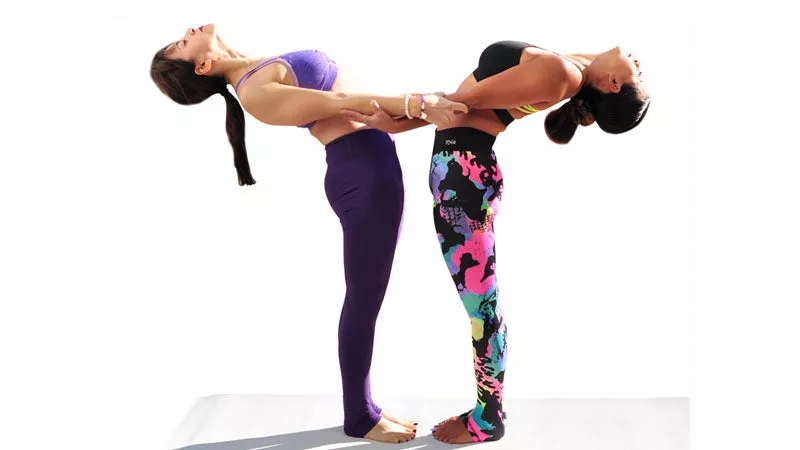
Benefits:
- Encourages Openness: The twisting motion stretches the chest and shoulders, symbolizing a willingness to open up to each other emotionally.
- Releases Tension: Twisting releases tension from the upper back and spine, promoting a sense of lightness and relaxation.
- Enhances Trust and Intimacy: Sharing the twist with your partner and relying on their support creates a feeling of mutual care and intimacy.
- Promotes Detoxification: Twisting motions gently massage the internal organs, aiding digestion and stimulating detoxification processes in the body.
How to Perform:
- Sit back-to-back with your partner in a comfortable cross-legged position. Ensure your spines are upright and touching for support.
- Inhale deeply as both partners lift their arms upward, stretching toward the ceiling.
- Exhale as you twist your torso to the right, placing your right hand on your partner’s left knee and your left hand on your own right knee.
- Hold the twist for 5 breaths, feeling the stretch in your back and shoulders.
- Return to the starting position, then repeat the movement on the left side.
Each of these poses offers a unique way to connect with your partner, blending mindfulness, physical fitness, and emotional bonding. Adjust the intensity as needed to match your comfort levels.
Tips for a Successful Couple Yoga Session:
Practicing yoga as a couple can be a deeply rewarding experience, but to ensure it’s enjoyable and beneficial for both partners, consider these detailed tips:
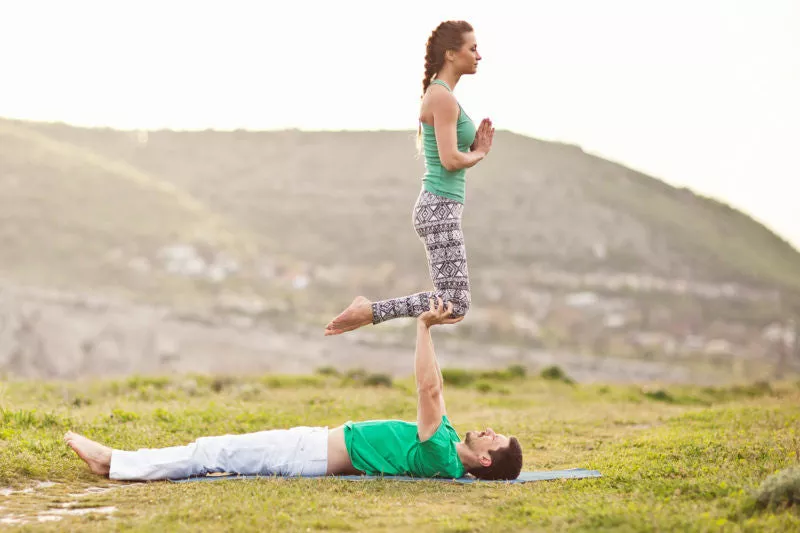
1. Communicate Openly and Honestly
- Why It Matters: Open communication helps both partners express their comfort levels, boundaries, and needs during the session.
- How to Do It: Before starting, discuss each other’s fitness levels and any physical limitations or injuries.
During the session, provide feedback to ensure both partners are aligned and comfortable in every pose.
Use verbal cues like “Is this okay?” or “Should I adjust?” to keep the flow harmonious.
2. Start Slowly and Warm Up Together
- Why It Matters: A proper warm-up prevents injury and prepares your bodies for deeper stretches and movements.
- How to Do It: Begin with gentle stretches or simple poses, such as seated forward folds or gentle twists.
Incorporate light breathing exercises to center your focus and synchronize your energy. Avoid jumping into advanced poses without building trust and flexibility.
3. Focus on Synchronizing Your Breaths
- Why It Matters: Matching your breathing patterns enhances connection and mindfulness, creating a shared rhythm.
- How to Do It: Use a simple inhale-exhale cycle where you both breathe in and out at the same time.
For example, during poses like the Seated Cat-Cow Stretch, inhale as you arch your back and exhale as you round it, coordinating with your partner’s movements.
4. Practice Patience and Flexibility
- Why It Matters: Couple yoga is about bonding, not perfection. A patient approach allows both partners to feel supported without pressure.
- How to Do It: If a pose feels difficult or awkward, take a break and try again without frustration.
Laugh off mistakes and enjoy the process, as it’s a journey of growth together rather than a performance.
5. Respect Each Other’s Boundaries
- Why It Matters: Everyone has different levels of comfort and ability, and respecting these differences fosters trust and safety.
- How to Do It: Avoid forcing a pose or pushing your partner beyond their limits. If one of you feels discomfort or strain, modify the pose or try a different one.
The goal is to enjoy the experience together, not to achieve perfection.
6. Choose the Right Environment
- Why It Matters: A calm and distraction-free setting enhances focus and relaxation.
- How to Do It: Pick a quiet, spacious area with soft lighting and a flat surface to practice.
Use yoga mats for cushioning and play soothing background music to create a peaceful atmosphere.
7. Incorporate Playfulness and Humor
- Why It Matters: Lightheartedness strengthens emotional bonds and makes the session more enjoyable.
- How to Do It: Don’t be afraid to laugh at yourself or your partner if a pose doesn’t go as planned.
Add fun challenges or try balancing poses that require extra teamwork to keep the energy playful and exciting.
8. End with Relaxation Together
- Why It Matters: A calm, shared moment of rest helps you both absorb the benefits of your practice and reinforces emotional connection.
- How to Do It: After completing your poses, lie down next to each other in Savasana (Corpse Pose).
Close your eyes, focus on your breath, and relax. You can hold hands or touch palms to deepen the connection.
9. Set Goals and Celebrate Progress
- Why It Matters: Working toward shared goals keeps you motivated and adds meaning to your practice.
- How to Do It: Set small, achievable goals for each session, such as improving balance in a pose or holding a stretch longer.
Celebrate milestones together, whether it’s mastering a difficult pose or simply enjoying the time spent as a couple.
10. Explore Advanced Poses Gradually
- Why It Matters: Progressing slowly helps build trust, strength, and flexibility over time.
- How to Do It: Once you feel confident in basic poses, challenge yourselves with slightly more advanced ones.
Always start with variations or modifications to ensure safety and comfort. Use props like yoga blocks or straps for additional support if needed.
By following these tips, you can create a meaningful, enjoyable couple yoga practice that nurtures both your physical health and emotional connection.

